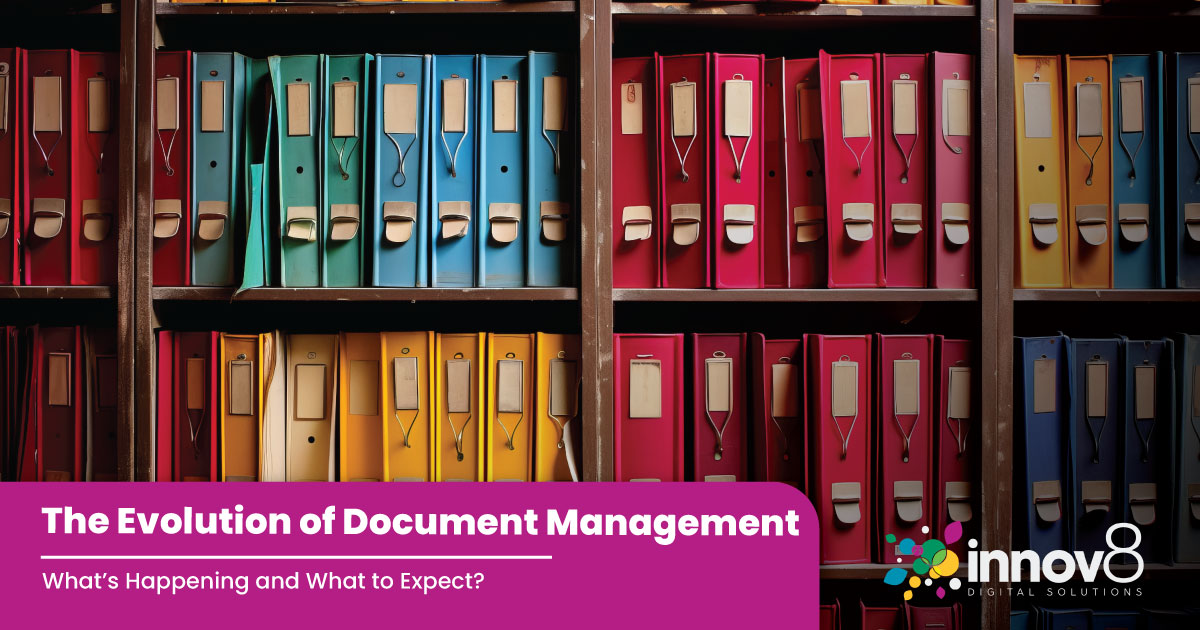The Role of CFOs: How Managed IT Solutions Providers Can Assist
In the fast-paced world of business and information management, the concept of document management has evolved from traditional file cabinets and paper trails into a dynamic and indispensable facet of modern operations. At its core, document management involves the systematic creation, organization, storage, retrieval, and secure handling of documents, whether in physical or digital form. Its importance cannot be overstated, as efficient document management is the bedrock upon which organizations build their operational foundations.
This evolution has been significantly accelerated by the relentless march of technological advancements. The digital revolution, combined with the advent of cloud computing, automation, and artificial intelligence (AI), has propelled document management into an era defined by unprecedented efficiency, accessibility, and security.
This comprehensive guide embarks on a journey through the past, present, and future of document management. It looks back at the traditional methods and their limitations, highlighting the compelling reasons behind the shift towards digitalization. Managed Print Services (MPS) will take center stage as a powerful ally in the world of document management. This guide also demystifies the transformative impact of cloud technology and the promising capabilities of automation and AI.
Reach out to innov8 for managed print solutions and managed IT services, or continue reading this guide to discover the evolution of document management and learn what's happening now and what exciting developments lie ahead.
The Traditional Approach to Document Management
For generations, the world of document management was synonymous with stacks of paper, filing cabinets, and painstaking record-keeping. This conventional approach, often called paper-based or manual document management, relied on tangible documents, handwritten records, and physical filing systems. While it served its purpose in a previous era, the limitations of this traditional method have become increasingly apparent in today's fast-paced and technology-driven world.
Traditional methods of document management
In a paper-based document management system, every piece of information, from invoices to contracts and correspondence, was stored as a physical document. These documents were typically organized into filing cabinets or folders, often labeled meticulously for easy retrieval. Information sharing was often limited to physical copies, requiring manual reproduction or postage for distribution. This approach was time-consuming, labor-intensive, and inherently susceptible to human error, loss, or damage.
Challenges and limitations of traditional document management
The drawbacks of traditional document management were numerous. Physical documents could be easily misplaced or damaged, leading to data loss. Retrieving specific information was often cumbersome, requiring extensive searching and manual sorting. Collaboration was hindered by the need to physically transport documents, resulting in delays and inefficiencies. Security concerns loomed large, as sensitive documents could be vulnerable to theft or unauthorized access.
Need for innovation and efficiency in handling documents
As businesses and organizations grapple with the demands of the digital age, the inefficiencies and limitations of traditional document management have become increasingly untenable. The need for innovation and efficiency in handling documents is pressing. Digitalization, automation, and adopting advanced document management systems have emerged as essential steps in streamlining processes, reducing costs, and enhancing security.
Now that you understand how document management worked traditionally let’s explore how these technological advancements have transformed the landscape of document management, opening up new possibilities and opportunities for organizations to thrive in an ever-evolving business environment.

The Emergence of Digital Document Management
The advent of digitalization has ushered in a profound revolution in the world of document management. This transformative shift from paper-based systems to digital document management has fundamentally reshaped how organizations create, store, access, and manage their critical information.
How digitalization has revolutionized document management
Digitalization has liberated document management from the constraints of physical paperwork. It involves the conversion of paper documents into digital formats, making them easily accessible, editable, and shareable. The process of scanning, digitizing, and archiving documents has not only eliminated the need for physical storage but has also opened up a world of possibilities regarding data handling and document workflows.
Benefits of digital document management systems
Digital document management systems offer a plethora of advantages. First, they provide increased accessibility, enabling authorized users to access documents remotely from any device with an internet connection. Second, these systems enhance searchability through robust indexing and search functions, allowing users to quickly locate specific documents and reducing time spent on manual searching. Finally, version control and audit trails ensure document integrity and compliance.

Managed Print Services (MPS) and Document Management
In the modern landscape of document management, Managed Print Services (MPS) have emerged as a pivotal component that not only streamlines document-related processes but also brings about substantial cost savings and enhanced security measures.
Role of Managed Print Services (MPS) in document management
MPS is a comprehensive solution designed to manage an organization's entire print environment, encompassing devices, supplies, maintenance, and workflows. Its role in document management is multifaceted. MPS optimizes print infrastructure, ensuring that the right devices are deployed in the right locations. It helps monitor and manage print volumes, reducing wastage and inefficiencies. Moreover, MPS provides insights into document-related processes, enabling organizations to make data-driven decisions for continuous improvement.
MPS streamlining document-related processes
MPS streamlines document-related processes by automating tasks such as supply replenishment, maintenance scheduling, and document routing. This automation minimizes downtime and frees up employees to focus on more strategic tasks. Additionally, MPS helps reduce costs through optimized print infrastructure, lower energy consumption, and decreased paper usage. Enhanced security is another crucial aspect, as MPS helps implement print policies, secure document storage, and track user activity, mitigating risks associated with unauthorized access or data breaches.
Let innov8 be your managed print service-providing partner in Western Canada and British Columbia regions. Explore locations where they offer services.
The Impact of Cloud Technology
Cloud technology has emerged as a game-changer in the document management department, fundamentally altering how organizations store, share, and manage critical documents.
Cloud technology is transforming document storage and sharing
Cloud technology has revolutionized document storage by shifting it from on-premises servers and physical hardware to remote, secure, and highly scalable online platforms. This transformation has eliminated the need for extensive physical storage spaces, reducing costs and the risk of data loss due to physical damage or theft. Additionally, cloud-based document sharing has become seamless, enabling real-time collaboration among distributed teams, clients, and partners. Gone are the days of emailing large attachments or dealing with version control issues; the cloud offers a centralized, accessible repository for documents of all types.
Cloud-based document management systems: Benefits
Cloud-based document management systems offer an array of advantages. Remote access is a key benefit, allowing authorized users to access documents from anywhere with an internet connection, promoting flexibility and productivity. Scalability is another significant advantage; organizations can easily expand their storage and processing capabilities as their document management needs grow, without the constraints of physical infrastructure. Additionally, cloud-based systems often feature automatic backups and version history, safeguarding documents against accidental deletion or data corruption.
Highlight security measures for data protection
Security is a paramount concern in cloud-based document management. Cloud providers implement robust security measures, including encryption, access controls, and authentication protocols, to safeguard sensitive documents. Compliance with industry regulations such as GDPR, HIPAA, and SOC 2 is a common practice, ensuring that data privacy and integrity are maintained. Regular security audits and updates further bolster protection. It's worth noting that cloud providers often invest significantly in cybersecurity, making it challenging for individual organizations to match the level of protection that the cloud can offer.
Cloud technology's transformative impact on document storage, sharing, and management has enabled organizations to operate more efficiently, securely, and collaboratively in an increasingly digital world.

Automation and Artificial Intelligence (AI)
In the evolving landscape of document management, automation and Artificial Intelligence (AI) are catalysts that are fundamentally reshaping workflows and redefining how organizations handle their documents.
Reshaping document management workflows
Automation and AI are revolutionizing document management workflows by introducing unprecedented levels of efficiency and accuracy. These technologies streamline repetitive tasks such as data entry, classification, and routing. They are capable of extracting insights and patterns from documents, thereby optimizing decision-making processes. This automation significantly reduces manual labor, lowers the risk of human error, and accelerates document processing, enabling organizations to be more agile and responsive.
Categorize, extract, and analyze data from documents
AI-powered tools leverage machine learning algorithms to categorize, extract, and analyze data from documents. Natural Language Processing (NLP) algorithms can understand and extract information from unstructured text, while Optical Character Recognition (OCR) technology can convert scanned text into machine-readable data. These tools can identify patterns, keywords, and context within documents, facilitating efficient data extraction and categorization. Moreover, they can perform advanced data analysis, enabling organizations to derive valuable insights from their document repositories.
Industries leveraging AI for document processing
Industries across the spectrum are harnessing AI for document processing. In healthcare, AI algorithms are employed to extract patient data from medical records, reducing administrative overhead and enhancing patient care. In finance, AI-driven document processing systems automatically extract and analyze financial data from invoices and receipts, improving accuracy in financial reporting. Legal firms use AI-powered tools to review and categorize legal documents, saving considerable time in litigation preparation. Government agencies utilize AI to process and analyze vast amounts of textual data from reports and archives, aiding decision-making and policy development.
Automation and AI are not merely trends; they represent a paradigm shift in document management, empowering organizations to harness the full potential of their document repositories and derive actionable insights from their data.

Future Trends and Innovations
The future of document management is poised to witness a fascinating amalgamation of cutting-edge technologies with trends that promise to redefine the way organizations handle their documents.
Predict upcoming trends in document management
Blockchain technology is poised to revolutionize document management by providing an immutable and tamper-proof ledger for document transactions. This integration will enhance document security and transparency, making it virtually impossible to alter or forge documents.
Virtual reality (VR) and augmented reality (AR) are emerging as tools for immersive document visualization and collaboration. Imagine dissecting complex data sets or schematics in a 3D virtual space, enabling a deeper understanding of the content.
Potential impact of quantum computing
Quantum computing holds the potential to disrupt document processing on an unprecedented scale. Its immense computational power can solve complex document-related problems and optimize search and analysis processes. Organizations will be able to process vast volumes of documents in near real-time, leading to faster decision-making and enhanced data insights.
Importance of staying updated with evolving technologies
Staying updated with evolving technologies is paramount in the world of document management. Failing to adapt to new trends can lead to inefficiencies, security vulnerabilities, and missed opportunities. Organizations must invest in continuous learning and the adoption of emerging technologies to remain competitive.
The future of document management promises a dynamic landscape characterized by blockchain-backed security, immersive VR and AR experiences, and the revolutionary power of quantum computing. Organizations that embrace these trends and prioritize technological innovation will enhance their document management capabilities and gain a significant competitive advantage in an increasingly digital world. As organizations journey to this exciting future, the message is clear: stay agile, stay informed, and stay at the forefront of technological innovation to unlock the full potential of document management.

Embrace the Change with innov8
innov8 stands at the forefront of this transformation, offering a suite of services that empower businesses to navigate the future of document management and process automation with confidence. Through their partnership with M-Files, innov8 enables organizations to harness the true potential of their data, turning it into actionable business intelligence. This collaboration provides secure access to documents and information, regardless of location, ensuring efficiency, productivity, and minimized risk.
So, as you embark on this journey of digital transformation, remember that the future of document management is not a distant horizon; it's here, and it's happening now. Embrace it with open arms, stay vigilant in adopting emerging technologies, and partner with innov8 to future-proof your business while you process, manage, retrieve, and save data with newfound ease and intelligence.


